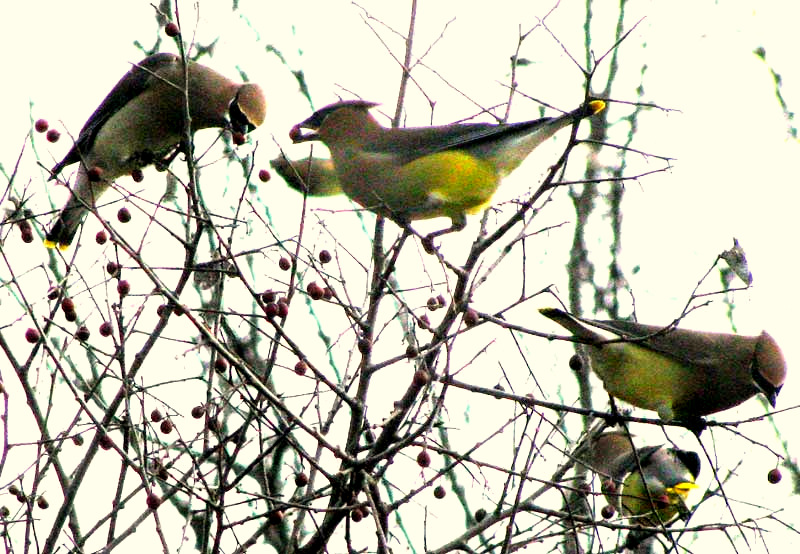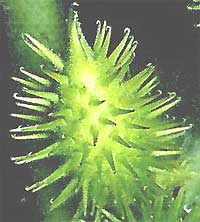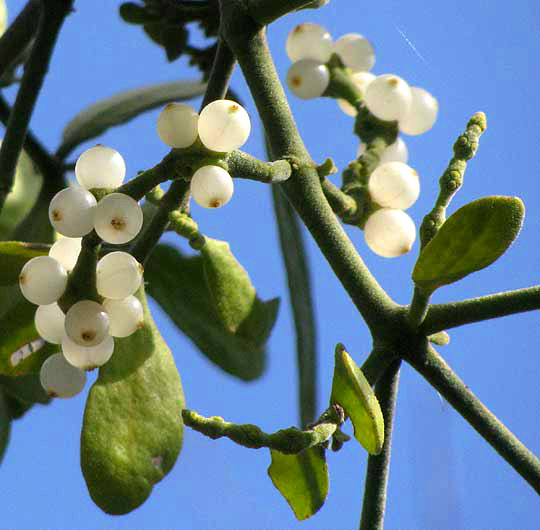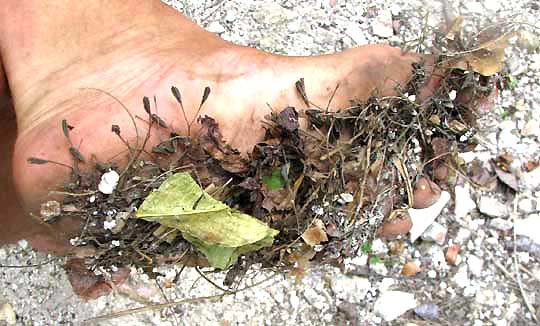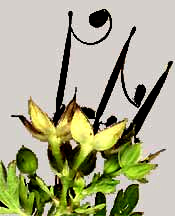 At the right you see a cluster of fruits and flowers of the common Wild Geranium, Geranium carolinianum. Sometimes this plant is also called the Carolina Storkbill because the fruits are long and slender, reminding some people of a stork's long bill. And it has a special way of transporting its seeds away from the parent plant:
At the right you see a cluster of fruits and flowers of the common Wild Geranium, Geranium carolinianum. Sometimes this plant is also called the Carolina Storkbill because the fruits are long and slender, reminding some people of a stork's long bill. And it has a special way of transporting its seeds away from the parent plant:
CATAPULTING. At the base of each of our geranium's "bill" reside five baglike things (the five carpels of the flower's earlier ovary). When the fruit is ripe, the baglike things break away from one another and each bag's "handle," which runs up the "bill," violently recoils, making the "bag" snap upward. During this upward-snapping process, the "bag's" seed is tossed away from the plant. In other words, each flower has five built-in "catapults" that physically toss the seeds into new territory. In the picture, two flowers show one of their "catapults" just after it's snapped upward, tossing its seed away. In the middle flower, inside the calyx, two "unsnapped bags" at the base of the "bill" await their turns to be catapulted.
WIND is one of the most important "seed dispersal agents." Plants employ several strategies for using the wind to carry away their fruits and seeds:
- Wind-catching tufts of hairs are attached to many kinds of light-weight, seed-like fruits and sometimes seeds themselves. The picture at the right shows the fruiting head of a False Dandelion, Pyrrhopappus carolinianus, of the Composite Family. An autumn cold front with strong winds easily can carry such "parachuted" fruits for hundreds of miles. Regular dandelions with their white, pom-pom-like fruiting heads produce similar fuzz-topped fruits. Other kinds of plants doing the same include asters, goldenrods, milkweeds, clematis, and willows.
- "Wings" appear on fruits of a number of backyard trees, including maples, ashes, elms, birches, and pines. The winged fruits at the right are those of the Red Maple, Acer rubrum. While winged fruits don't float in the air like dandelion achenes do, they certainly can spin to the ground a good distance from the parent. Kids often call maple fruits "helicopters" because of their spinning. Of course the taller the tree is, the farther its winged fruits can spin away. This means that any tree robust enough to grow very tall will send its genetic material into new territory faster than smaller trees -- a neat example of how "survival of the fittest" works.
- Being very small is a simple but very successful wind-dispersal strategy. The picture at the right shows a "spore print" made by placing the cap of a Cone Cap Mushroom, genus Conocybe, atop a piece of paper and waiting a few hours as millions of microscopic spores fell from the mushroom's gills. A spore is so lightweight that if the stiff winds of a weather front push through while the spores are falling, the spores might be transported by the wind for hundreds of miles. Mosses, lichens, algae, and other fungi produce diffuse clouds of such spores or dust-like fragments of themselves.
- Bladder-like fruits are those in which the fruits are enclosed in an inflated, papery structure which can be rolled over the ground or snow by wind. You might see this kind of fruit in your backyard if you grow Chinese-Lantern Plant or Tomatillos in your garden, or if you have a weedy area nearby where Ground Cherries grow. At the right, that's a Tomatillo or Husk Tomato, Physalis ixocarpa, its green-tomato-like fruit surrounded by a papery husk, which is the original flower's inflated calyx.
- Tumbling is a wind-disseminating strategy you might see if you live near an open, weedy area. Here the seed-bearing part of the plant or the entire plant snaps off at the base and rolls with the wind, dropping seeds as it tumbles. The most famous example is the Tumbleweed, but Russian Thistles also do it. Below you can see the flowering head of Tropical Panicgrass, Panicum trichoides. When this grass's seeds are mature the entire inflorescence breaks from the plant and on windy days can be seen rolling across fields. If the wind is really stiff, the whole inflorescence lifts into the air and can be carried for miles!
- Agitation/ slinging/ knocking spreads seeds for several common backyard garden plants such as irises, evening-primroses, poppies, and larkspurs. At the right you see an iris's split-open, capsule-type fruit. The capsule had been three-sided, and now the three capsule walls have split apart, each wall taking its red seeds with it. When the wind blows, the flat, pappery capsule walls shake, tossing the red seeds about so vigorously that the threadlike "stems" holding the seeds onto the walls snap and the seeds are slung a fair distance onto the ground.
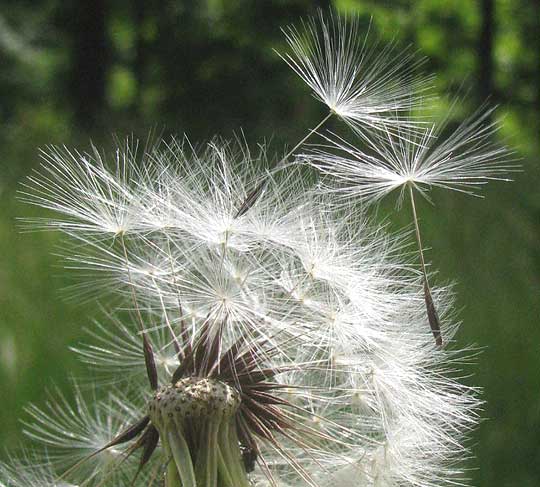
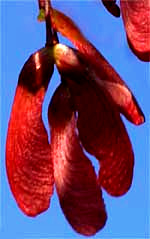
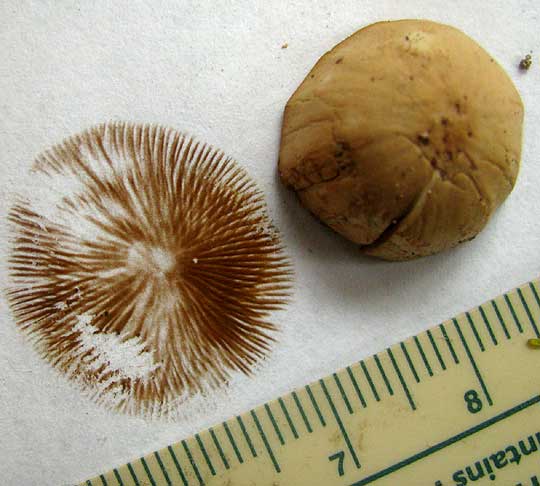
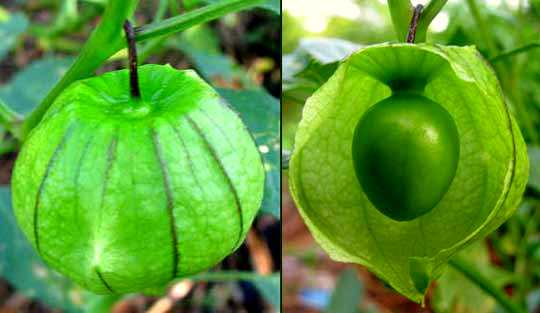
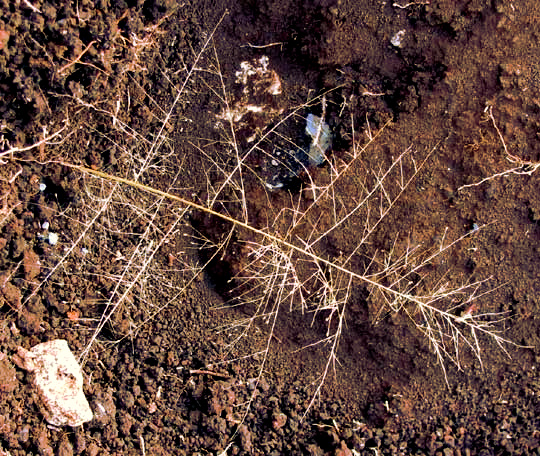
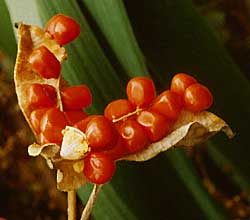
ANIMALS are the other main transporters of plant fruits and seeds into our backyards. Here are the main ways they accomplish that:
- Fruits with seeds inside them are eaten by animals who carry the seeds elsewhere inside their bodies. The fleshy, nutritious part of the fruit covering the seed or seeds is digested, then the hard seeds themselves, still intact and normally well away from where they were ingested, exit the bird. That can be either by regurgitation through the mouth or by being dropped in the feces. At the right, Cedar Waxwings, Bombycilla cedrorum, feed on hackberry fruits, which consist of a single hard, spherical seed thinly covered with sweet, nutritious flesh. The fruits are swallowed whole, then later the naked seeds are chucked up through the mouth. Of course only animals who swallow seeds whole are good "dispersal agents." Grosbeaks are birds who crack the seeds' hard coverings and eat the seeds' contents, so nothing alive gets dispersed.
- Caching, pronounced "cashing," is seen among backyard squirrels who bury acorns and other nuts for winter use. When these caches are forgotten or the cacher dies, the buried seeds find themselves nicely planted, ready to sprout in the spring. Many rodent species besides squirrels cache smaller fruits, but their activities usually take place at night, so we don't notice them.
- Clinging is seen among fruits equipped with hairs or spines specially adapted for latching onto passing animals -- or backyard- naturalists' trouser legs. At the right is an immature cocklebur fruit about the size of a pea. Cocklebur, Xanthium strumarium, is a fairly common European weed in parts of North America. Notice the hooks on the spine tips. When these spines penetrate a rabbit's fur, a dog's long tail hairs or a naturalist's socks, it's hard to get the fruit free. If a spine penetrates your skin and one of those tiny hooks curves around inside your flesh, pulling the spine out is no fun!
- The mistletoe strategy. At the right you see the pretty fruits of the mistletoe species Phoradendron leucarpum. Inside each fleshy, berry-type fruit several seeds are embedded in very sticky juice. When a bird eats these fruits, the tiny seeds adhere to the bird's beak. When the bird flies to a tree branch to digest, the bill gets wiped on a branch's bark. At that moment the wiped-off seeds find themselves exactly where they need to be -- where they can germinate "roots" to grow into the tree, to start stealing the tree's nutrient-rich sap. Mistletoes are "semi-parasitic," in that they rob nutrients from their host trees, but with their green leaves photosynthesize their own food from the robbed nutrients.
- Sticky fruits. Some fruits are covered with hairs atop which reside sticky glands. The result can be something like you see at the right. Those are fruits of the tropical semi-vining bush or tree sometimes called Catchbird Tree, Pisonia aculeata. When you scrape them off your foot and walk away, the seeds have then been smartly disseminated.
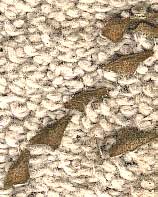
- Humans transport vast numbers of wild fruits and seeds, both intentionally and unintentionally. At the right, seed-bearing fruit-sections of Tick Trefoil, Desmodium paniculatum, hitch a ride on a wanderer's socks. When a lawn is sown in bluegrass, there just might be a few weed seeds accidentally included in the seed bag. Fill dirt trucked in to level a lawn's low spot might introduce some fascinating invaders. Automobiles and trains may carry a few weed seeds on their underparts. Well, the avenues by which humans can spread seeds are practically endless.
